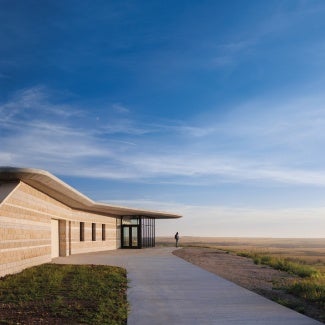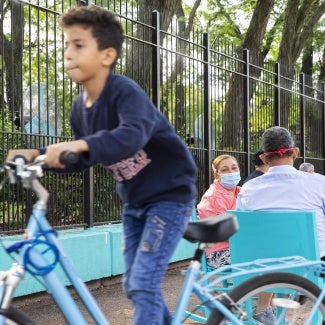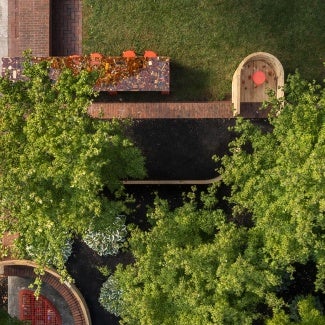Henry Island Guesthouse
The award-winning small project design of the Henry Island Guesthouse honors the natural beauty of its remote island location while adding flexibility to an existing family retreat.

Project highlights: Henry Island Guesthouse
- Architecture firm: Bohlin Cywinski Jackson
- Location: Henry Island, Wash.
- Category: Two
- Project site: Previously developed
- Building program type(s): Residential - single-family detached
On a secluded site in Washington’s San Juan Islands, the Henry Island Guesthouse is a new addition to a main residence the team previously designed. The sensitively scaled dwelling reflects the vocabulary of the main home while also forging its own identity and allows a new set of owners to welcome family and friends for extended periods.
The initial residence on the 24-acre property was designed in 2012 and sits in a central meadow that overlooks a nearby shallow bay. New owners purchased the property in 2016 and reengaged the team for a guesthouse that respects the character of the island and its few scattered homes. The guesthouse’s location was informed by the experience of arriving to the island by boat, where a winding path leads from a dock through quiet woodlands before ultimately arcing back to the main residence.
For a young family from Seattle, the main home is a summer retreat from the bustle and congestion of city life. The idyllic Henry Island is not serviced by any ferries, and the clients enjoy hiking, kayaking, and sailing the remote setting with family and friends. While the original home is quite spacious, it was designed to accommodate a single family.
The 1,350-square-foot guesthouse sits uphill from the primary home and marks the transition from dense forest to sunlit meadow. One end is anchored into the gentle slope, while its opposite hovers above the landscape upon slender columns. The program includes a pair of bedroom suites, each with distinguishing characteristics requested by the client, and a central living area that features a small kitchen where guests can begin and end their day on the island. The guesthouse’s adjacency to the main residence fosters a connection between both buildings while still maintaining privacy and respect for the site’s natural characteristics.
Materials for the main residence comprised steel, exposed Douglas fir framing, and glass, with weathered steel and cedar wrapping the exterior. Similar materials were used in the guesthouse to form a visual link between the two. The guesthouse’s entrance is signaled by a cast-in-place concrete ledge, which further tethers the building to the earth, and an aperture within the steel wall. Drawing inspiration from the main residence’s breezeway, the guesthouse’s form was envisioned as a covered porch flanked by its bedroom suites. Large sliding-glass doors that disappear into the walls on two sides open the space to the sights, smells, and sounds of the secluded island.
Framework for Design Excellence measures
Was there a design charrette? Yes
Level of community engagement:
Collaborate: A partnership is formed with stakeholders to share in the decision-making process including development of alternatives and identification of the preferred solution.
Site area that supported vegetation (landscape or green roof) pre-development: 100%
Site area that supports vegetation post-development: 88%
Site area covered by native plants supporting native or migratory species and pollinators: 88%
Strategies used to promote Design for Ecosystems: Biodiversity, Soil conservation, Habitat conservation, flora/fauna
Is potable water used for irrigation? No
Is potable water used for cooling? No
Is grey/blackwater reused on-site? No
Is rainwater collected on-site? No
Stormwater managed on-site: 100%
2030 Commitment baseline EUI: 39 kBtu/sf/yr
Predicted net EUI including on-site renewables: 23 kBtu/sf/yr
Reduction from the benchmark: 40%
Is the project all-electric? Yes
Level of air filters installed: MERV 15-16
Was a “chemicals of concern” list used to inform material selection? Yes
Do greater than 90% of occupied spaces have a direct view to the outdoors? Yes
Were embodied carbon emissions estimated for this project? No
Estimated service life: 75 years
Floor area, if any, representing adapting existing buildings: 0%
Ability to survive without utility power: Partial back-up power
Risk assessment and resilience services provided: Hazard identification, Climate change risk, Building vulnerability assessment, Hazard mitigation strategies above code
Has a post-occupancy evaluation been conducted? No, but a POE will be conducted
Building performance transparency steps taken:
Present the design, outcomes, and/or lessons learned to the office.
Present the design, outcomes, and/or lessons learned to the public.
Project team & jury
Year of substantial project completion: 2021
Gross conditioned floor area: 1348 sq. ft.
General Contractor: Hoxie Huggins Construction
Structural Engineer: PCS Structural Solutions
Photography: Aaron Leitz and Ben Benschneider
Chandra Robinson, AIA, (Chair), LEVER Architecture, Portland, Ore.
Katherine Hogan, AIA, Katherine Hogan Architects, Raleigh, N.C.
Chris Baribeau, AIA, Modus Studio, Fayetteville, Ark.
David Corban, AIA, David Corban Architects, Naples, Fla.
Madhubala Ayyamperumal, Assoc. AIA, Gensler, San Francisco
AIA and its Small Project Design (SPD) Knowledge Community present the annual Small Project Award Program to raise public awareness of the value and design excellence that architects provide regardless of the limits of size and budget.
Nine projects showcase the best small project design and the big impact small projects can have on people and communities.













